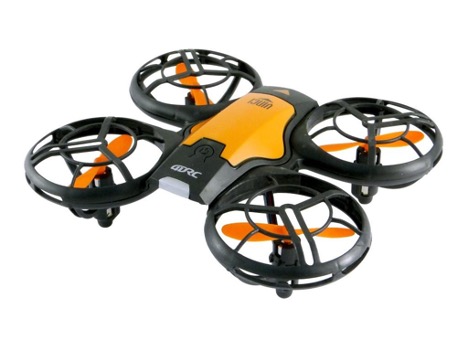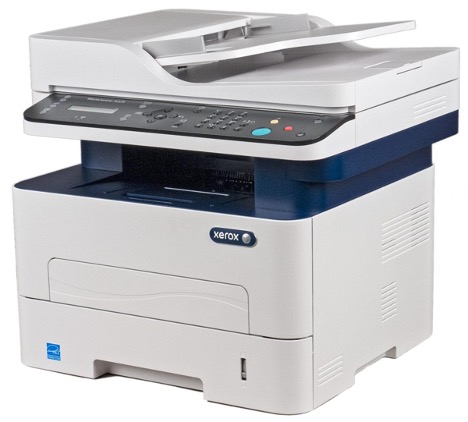How to choose a projector screen: the optimal size for your home
There are several criteria by which you can understand how to choose a screen for a projector. First of all, it is important to take into account the dimensions and aspect ratio, and the optimal parameters should be calculated independently. How to do this, as well as what additional indicators to pay attention to, is described in detail in the presented article.
The content of the article
Aspect ratio and dimensions
This is one of the most important indicators that you should immediately pay attention to. When choosing a canvas, as the screen for the projector is called, we focus on 3 parameters:
- aspect ratio of the image produced by the projector;
- its installation location – distance to the screen;
- projector screen size and aspect ratio.
One of the popular image aspect ratios (video, photo) is 16:9. There is also a 4:3 option, but it is more suitable for presentations, i.e. use in the office. Therefore, for your home you should choose a canvas with a popular ratio of 16:9 or 16:10. In the latter case, the surface will be fully used for video with a resolution of 1280*800 or 1920*1200.
If you want to watch movies like in a real cinema, you can take a canvas with a ratio of 2.39:1 (there are 2 more options - 2.35:1 and 2.40:1). Here's what projector screen you can choose to create a completely immersive experience.
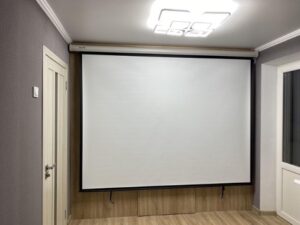
To determine the dimensions, you need to clarify the distance of the projector from the screen and divide it by the throw ratio (the result will be the width parameter). As an example, consider this:
- Ratio 16:9, i.e. 1.78.
- Distance 4 m.
- 4/1.78 = 2.25 m.
- Based on the ratio 16:9, the length can be calculated: 2.25 * 9/16 = 1.27 m.
It’s clear what the projector canvas is called and how important the aspect ratio is. If you select the parameters optimally, there will be practically no inactive areas left on the screen. Although it will still not be possible to do this perfectly accurately, since image formats (both video and photos) are different.
Types of screens
The choice of screen for a projector is quite wide, since there are different types of designs and canvases themselves. Each of them has its own characteristics, pros and cons.
Types of canvas
There is no doubt about whether a projector screen is needed. Simply displaying an image on the wall is a bad option and will ruin the impression of even the highest quality picture. Depending on the composition of the material and color, the following types are distinguished:
- White matte canvas (lambert) is the standard, most common material that evenly reflects light in all directions. If you figure out how to choose a screen for a projector, you can choose this option. But then you should remove all light objects from the room, as they can distort perception.
- If the room has a light interior (wallpaper, furniture), it is best to purchase a gray screen. In this case, the reflection coefficient does not exceed 0.8, so the transmission of light, including contrast, will be of higher quality.
- If the room is quite dark, you should understand in advance which projector screen to choose for your home. In this case, the best solution would be a glossy canvas with a reflectance coefficient greater than 1.
- Composite ALR canvas combines the advantages of matte and glossy surfaces. Particularly suitable for rooms with a bright interior.
- The CLR canvas is a rare option that is suitable if the projector is located at a distance of only 30 cm from the screen.
Types of construction
Also, when choosing, you need to take into account the overview of the projector screen and the structure to which the screen is attached. There are 2 main types - stationary and mobile. The stationary ones, in turn, include the following varieties:
- On a frame - the canvas is hung from it, and the frame itself is hung from the wall. Thanks to this, the screen is tightly stretched, which guarantees high quality images. If space allows, the structure can be installed in a small recess - then you get a real home theater.
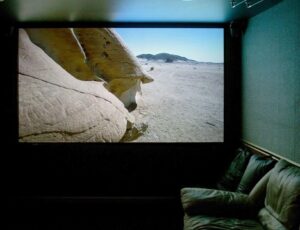
- It’s clear what the white canvas for the projector is called. This is a matte material that provides good color rendition. Moreover, the canvas can not only be hung, but also rolled into a roll. This design is attached to the wall or ceiling. A weighting agent is suspended at the bottom, making the surface perfectly flat.
There are also mobile structures that can be moved to different places:
- The best projector screens can also be rolled. Moreover, it can be transported to different places, so this type is classified as mobile.
- A screen with a collapsible frame is something between stationary and portable structures.A distinctive feature is that they can be quickly disassembled and assembled, which is especially useful for a small room. The tension is tight and even, resulting in high quality images.
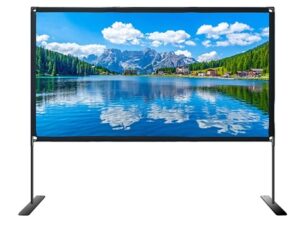
- A less common type for home use is the inflatable screen. In this case, the canvas is placed on a trampoline, which is inflated in a few minutes using an electric pump.
Technical specifications
When choosing the best screen for a projector, we focus on the rating of the highest quality models, as well as technical characteristics:
- The reflection coefficient directly depends on the material from which the canvas is made. It is optimal to choose products with a coefficient of 0.8-1.0.
- Viewing angle is an indicator related to reflection coefficient. If you purchase a typical matte white canvas, the view will be maximum. This way, all viewers can enjoy the same picture quality.
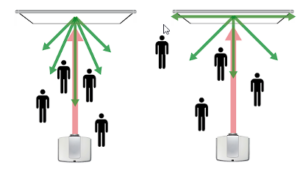
- Surface material – vinyl or textile. Both options are suitable, but you need to take into account the reflection coefficient.
Thus, when choosing a screen, it is important to take into account the characteristics of the room (how light or dark it is), aspect ratio and size. It is optimal if the lower part of the canvas is located at a height of 1.2 m from the floor, and the minimum distance to the viewer is 2 times greater than the height of the canvas. Thanks to this, you can ensure the most comfortable viewing of videos and photos.




